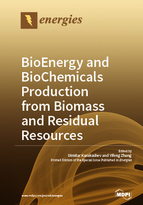BioEnergy and BioChemicals Production from Biomass and Residual Resources
A special issue of Energies (ISSN 1996-1073). This special issue belongs to the section "A: Sustainable Energy".
Deadline for manuscript submissions: closed (15 April 2018) | Viewed by 114187
Special Issue Editors
Interests: biofuels; biorefinery; biotechnology; microorganisms
Special Issues, Collections and Topics in MDPI journals
Interests: microbial electrochemistry; biogeochemical cycles; gas fermentation and anaerobic digestion
Special Issues, Collections and Topics in MDPI journals
Special Issue Information
Dear Colleagues,
We are inviting submissions to a Special Issue of Energies entitled “BioEnergy and BioChemicals Production from Biomass and Residual Resources”.
Research and technology developments in bioenergy and biochemical production systems are of utmost important for the development of next generation, high efficient biomass conversion concepts maximizing total energy and chemicals output. Utilization of non- conventional biomasses and unexploited residual resources (e.g., aquatic feedstocks, exhaust and industrial flue gases), innovative solutions for online monitoring and process control, novel biochemical pathways, microbial platforms and reactor technologies is a key issue to be addressed.
However, major challenges have still to be solved, such as the design of high performance and cost-effective technologies for production of bioenergy (gaseous, liquid, sold biofuels, renewable electricity) and biochemicals from residual resources in a biorefinery concept, where the potential of the biomass and residual waste streams is fully valorized.
In this context, evaluation of the environmental, technological, economical, and social sustainability of the concepts developed are of utmost importance.
The main objective of this Special Issue is, hence, to provide cost- effective and technologically sound solutions for next generation bioenergy and biochemical production systems.
The particular topics of interest include, but are not limited to:
- Novel and un-exploited residual resources for next generation biorefineries
- New emerging bioenergy and biochemicals production technologies
- Biochemicals pathways involved in biofuels and biochemicals production
- Microbial ecology of the biomass conversion processes
- Bioreactors for bioenergy and biochemicals production
- Novel approaches for biosystems sustainability evaluation
Dr. Dimitar Karakashev
Dr. Yifeng Zhang
Guest Editors
Manuscript Submission Information
Manuscripts should be submitted online at www.mdpi.com by registering and logging in to this website. Once you are registered, click here to go to the submission form. Manuscripts can be submitted until the deadline. All submissions that pass pre-check are peer-reviewed. Accepted papers will be published continuously in the journal (as soon as accepted) and will be listed together on the special issue website. Research articles, review articles as well as short communications are invited. For planned papers, a title and short abstract (about 100 words) can be sent to the Editorial Office for announcement on this website.
Submitted manuscripts should not have been published previously, nor be under consideration for publication elsewhere (except conference proceedings papers). All manuscripts are thoroughly refereed through a single-blind peer-review process. A guide for authors and other relevant information for submission of manuscripts is available on the Instructions for Authors page. Energies is an international peer-reviewed open access semimonthly journal published by MDPI.
Please visit the Instructions for Authors page before submitting a manuscript. The Article Processing Charge (APC) for publication in this open access journal is 2600 CHF (Swiss Francs). Submitted papers should be well formatted and use good English. Authors may use MDPI's English editing service prior to publication or during author revisions.
Keywords
- Non- conventional residual resources for a bioeconomy
- Emerging technologies for bioenergy and biochemicals production
- Liquid, gaseous and solid biofuels
- Microbial electrochemistry
- Biorefineries
- Sustainability assessment of bioenergy and biochemicals production






